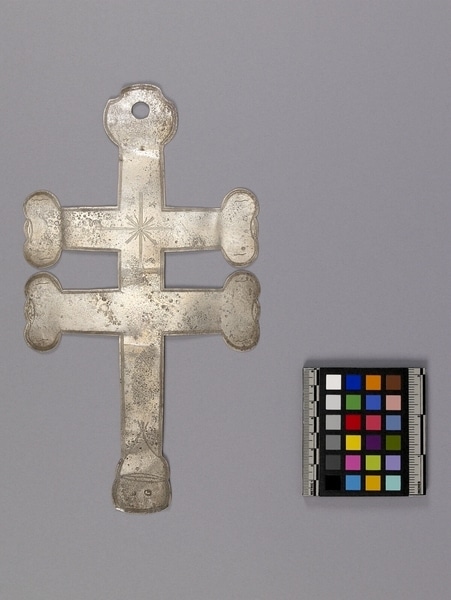Double Cross Item Number: 1590/3 from the MOA: University of British Columbia

Description
Broad, flat Lorraine Cross with trefoil terminals. Engraved zigzag decoration around edges with cross-line sunburst design in centre. Maker's stamps in cartouches at bottom, and hole cut in top.
History Of Use
Silver ornaments represent an important part of early exchange between Europeans, including fur traders, and first nations people, especially in Eastern and Central Canada and the USA. Initially, the main sources of silver were British, French, and Spanish coins. Most ornaments were produced by silversmiths of European origin in North America and Europe, and were actively traded only from 1760 to 1821. By the mid-18th century silver objects were produced in New England, Quebec and Montreal. Silver was used by first nations people as a sign of rank. Silver ornaments in these styles continue to be produced by native silversmiths in central Canada and the USA. The cross was the oldest form of trade silver, introduced by French missionaries to North America for presentation to converts. Crosses were later used as trade silver with no religious connotations. They circulated well into the 19th century, and were worn on the chest or as ear ornaments.
Cultural Context
trade; personal ornamentation; political alliance
Specific Techniques
Roulette engraving produces a uniform zigag, an identifying feature of the technique, and is created by using a revolving disk with sharp teeth.
Item History
- Made by Simon Charles Curtius (Maker) in Montreal, Quebec, Canada between 1760 and 1821
- Owned by Kathleen E. Reif before September 9, 1993
- Received from Kathleen E. Reif (Donor) on September 9, 1993
What
Who
- Culture
- Eastern Woodlands
- Creator
- Simon Charles Curtius (Maker)
- Previous Owner
- Kathleen E. Reif
- Received from
- Kathleen E. Reif (Donor)
Where
- Holding Institution
- MOA: University of British Columbia
- Made in
- Montreal, Quebec, Canada
When
- Creation Date
- between 1760 and 1821
- Ownership Date
- before September 9, 1993
- Acquisition Date
- on September 9, 1993
Other
- Item Classes
- metalwork
- Condition
- good
- Accession Number
- 1590/0003